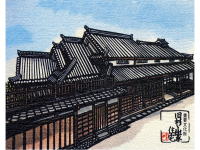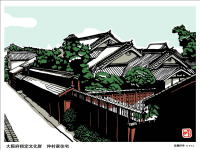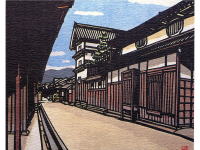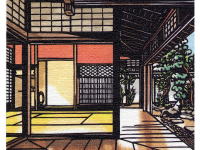富田林寺内町の探訪
I'm glad to intorduce an old town, Jinaimachi, Tondabayashi, Osaka, Japan as a national historic district and heritage site.
It takes 30 minutes from Osaka city to Tondabayashi station by Kintetsu railways. A 10-minutes walk will take you to the historic town.
ギャラリー
residence of the Sato Family
| 【Tourist guide to Jinaimachi town, Tondabayashi, a histric district and heritage site of Japan, Residence of the Sato family Page 1/2】 | ||||
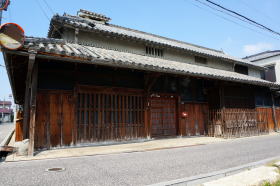 |
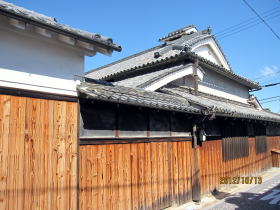 |
|||
| Kemuridashi-yagura (Koshi-yane) Overtopped roof to cover smoke vent In order that smoke of cooking stove placed on the earthen floor may be evacuated outdoors, a vent on the ridge of the roof is set up and covered by a small roof (a overtopped roof) |
||||
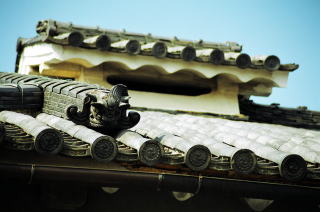 |
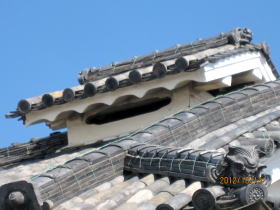 |
|||
 gable with a vent |
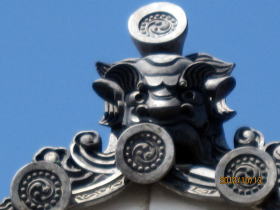 oni-gawara, a ridge-end tile bearing the face of demon as a talisman |
|||
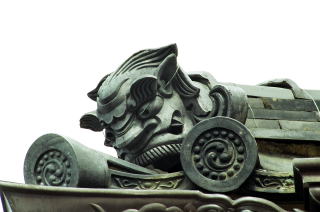 oni-gawara, a ridge-end tile bearing the face of demon as a talisman |
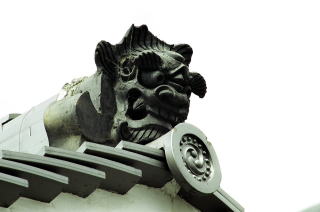 oni-gawara, a ridge-end tile bearing the face of demon as a talisman |
|||
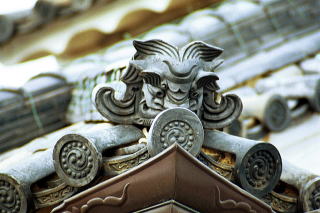 oni-gawara, a ridge-end tile bearing the face of demon as a talisman |
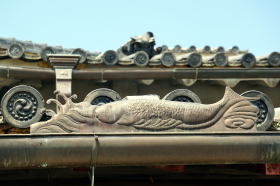 gutter with decoration of fish |
|||
| Zushi-Nikai or Tsushi-Nikai The second floor with a low ceiling, which is seen on plastered wall of farmhouses found in Kansai region. Mushikagomado (Mushikomado) The second floor windows with a plastered grid on the plasterer wall of buildings. It is believed to have developedthrough the vent holes of the second floor with low ceiling. There are also often used in townhouses, and some are in shape of patterns and trademarks. |
||||
 |
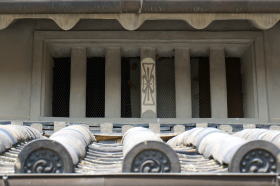 |
|||
| Latticed windows Musou-mado, Ara-goushi, Bekako-mado Old exterior window structure that combines vertical or horizontal wooden laths or bamboo being embeded on the outer frame of lintel (one with grooves for sliding doors), and sliding door made of wooden laths inside. The windows can be opened and closed by the movement of the door. It is also referred to as either Musou ,or Musou-renji-mado, or Musou-do. It is also called Bekako-mado in Jinaimachi town in Tondabayashi. Mochiokuri (Corelling) In order to support the part that protrudes, such as bay windows and eaves (sunshade), the diagonal wooden member or wooden plate to be attached to the wall or a pillar. |
||||
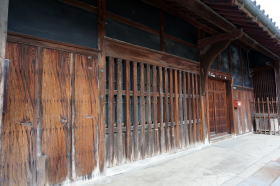 |
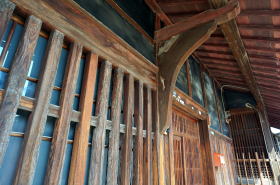 (center) mochiokuri |
|||
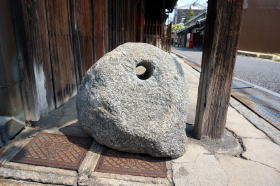 koma-tsunagi stone to tie oxen and horses, which is placed on the roadside of an old townhouse. |
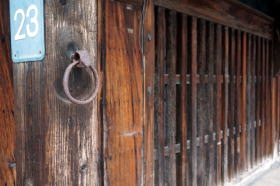 Koma-tsunagi ring to tie oxen and horses, which is placed on the roadside of an old townhouse. |
|||
| 【Tourist guide to Jinaimachi town, Tondabayashi, a histric district and heritage site of Japan, Residence of the Sato family Page 2/2】 | ||||
|
||||
Information

Not open to the public
(private residence)
Year built:
1820
Location:
At the intersection of Kamegasuji street and Kita (north) Kiashoi-cho street
in Jinaimachi town.
Trade name: Sadofuji
History (Origin)
Features of the buildings
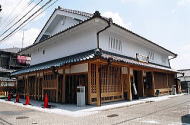
Visitor Center
(Jinaimachi Kouryuukan,
Town Community Center)
Address
9-29, Tondabayashi-cho, Tondabayashi city, Osaka, 584-0033, Japan
TEL.+81-(0)721-26-0110
FAX.+81-(0)721-26-0110
open 10a.m. until 5 p.m.
closed on Monday
The site-seeing map
available in English. Please stop by to the Tourist Information Cetnter
or Jinaimachi Visitor Center.
Restrooms
Available at Jinaimachi Visitor Center (Jinaimachi Kouryuukan), Jinaimachi
Center and Jinaimachi Tenbou Hiroba (Viewing Terrace)
Visitor Parking
Road width is very narrow in Jinaimachi town. If traveling by car, please
use Tondabayashi Municipal east parking newly opened in February 2014 (Toll
parking).
You can park the minibus for groups and passenger cars for general use.
Only one parking lot available for minibus, you must book it in advance
with Tondabayashi City Hall. A 15-minute walk to the Jinaimachi Visitor
Center and 5 minute walk up to the former Sugiyama family house, an important
national cultural property.
You will note that the large tourist bus for groups is requested to be
parked at the Tondabayashi City Hall No. 2 parking lot alongside the old
Route 170 (It must be booked in advance to City Hall). 20-minute walk to the Jinaimachi
Visitor Center and 10 minute walk up to the former Sugiyama family house,
an important national cultural property. Thank you in advance for your
kind cooperation.
